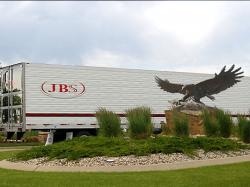Brazilian Meatpacker JBS Wrangles The US Beef Industry
September 20, 2013 | 2 min to read

Blood is everywhere in JBS’s (JBSS3:BZ) vast slaughterhouse in Greeley, Colo., north of Denver. It’s puddled on concrete floors, smeared on workers’ white smocks, gushing from cattle knifed on the killing floor. The smell hangs on the air in a high-ceilinged room chilled to about 40F, where JBS employees in shiny black and white helmets toil at chopping tables along both sides of a conveyor belt. A sign identifies it as the “LOIN” line. With hooks in one hand and knives with flexible 6- to 8-inch blades in the other, they trim fat and pare as much muscle from the bone and vertebrae as they can, turning raw slabs into tenderloins and New York strips.
“Disassembly” lines like this one, relying not on robots but humans, are where JBS and other meatpackers make money. Profit margins are slim in the meat business, and economies of scale elusive. Rivals buy essentially the same livestock and birds, fatten them on the same feed, and hope to whittle extra scraps of profit by being the most efficient at turning carcasses into salable cuts. “Planes can go around the world, iPhones can do a zillion things, but humans have not invented a machine that can debone a cow or a chicken as efficiently as a human being,” says Alan Alanis, a JPMorgan Chase (JPM) analyst.
At JBS the human beings are deboning steers and heifers faster and more efficiently than many. Each day the Greeley plant’s 3,200 workers can slaughter and debone 5,400 head of cattle, producing 3.3 million pounds of meat ready for supermarkets and restaurants. Beef expertly cut from the bone can fetch $10 a pound at retail, while leftover scraps can get a 10th of that, quickly adding up to a lot of lost profit.
To read the rest of the story, please go to: Bloomberg Businessweek
